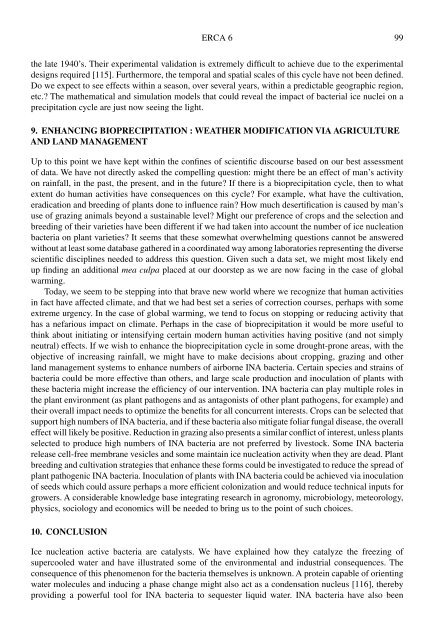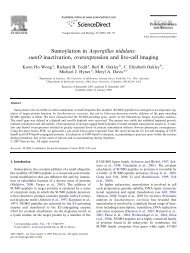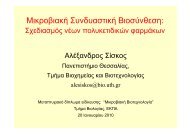Ice nucleation active bacteria and their potential role in precipitation
Ice nucleation active bacteria and their potential role in precipitation
Ice nucleation active bacteria and their potential role in precipitation
Create successful ePaper yourself
Turn your PDF publications into a flip-book with our unique Google optimized e-Paper software.
ERCA 6 99<br />
the late 1940’s. Their experimental validation is extremely difficult to achieve due to the experimental<br />
designs required [115]. Furthermore, the temporal <strong>and</strong> spatial scales of this cycle have not been def<strong>in</strong>ed.<br />
Do we expect to see effects with<strong>in</strong> a season, over several years, with<strong>in</strong> a predictable geographic region,<br />
etc.? The mathematical <strong>and</strong> simulation models that could reveal the impact of <strong>bacteria</strong>l ice nuclei on a<br />
<strong>precipitation</strong> cycle are just now see<strong>in</strong>g the light.<br />
9. ENHANCING BIOPRECIPITATION : WEATHER MODIFICATION VIA AGRICULTURE<br />
AND LAND MANAGEMENT<br />
Up to this po<strong>in</strong>t we have kept with<strong>in</strong> the conf<strong>in</strong>es of scientific discourse based on our best assessment<br />
of data. We have not directly asked the compell<strong>in</strong>g question: might there be an effect of man’s activity<br />
on ra<strong>in</strong>fall, <strong>in</strong> the past, the present, <strong>and</strong> <strong>in</strong> the future? If there is a bio<strong>precipitation</strong> cycle, then to what<br />
extent do human activities have consequences on this cycle? For example, what have the cultivation,<br />
eradication <strong>and</strong> breed<strong>in</strong>g of plants done to <strong>in</strong>fluence ra<strong>in</strong>? How much desertification is caused by man’s<br />
use of graz<strong>in</strong>g animals beyond a susta<strong>in</strong>able level? Might our preference of crops <strong>and</strong> the selection <strong>and</strong><br />
breed<strong>in</strong>g of <strong>their</strong> varieties have been different if we had taken <strong>in</strong>to account the number of ice <strong>nucleation</strong><br />
<strong>bacteria</strong> on plant varieties? It seems that these somewhat overwhelm<strong>in</strong>g questions cannot be answered<br />
without at least some database gathered <strong>in</strong> a coord<strong>in</strong>ated way among laboratories represent<strong>in</strong>g the diverse<br />
scientific discipl<strong>in</strong>es needed to address this question. Given such a data set, we might most likely end<br />
up f<strong>in</strong>d<strong>in</strong>g an additional mea culpa placed at our doorstep as we are now fac<strong>in</strong>g <strong>in</strong> the case of global<br />
warm<strong>in</strong>g.<br />
Today, we seem to be stepp<strong>in</strong>g <strong>in</strong>to that brave new world where we recognize that human activities<br />
<strong>in</strong> fact have affected climate, <strong>and</strong> that we had best set a series of correction courses, perhaps with some<br />
extreme urgency. In the case of global warm<strong>in</strong>g, we tend to focus on stopp<strong>in</strong>g or reduc<strong>in</strong>g activity that<br />
has a nefarious impact on climate. Perhaps <strong>in</strong> the case of bio<strong>precipitation</strong> it would be more useful to<br />
th<strong>in</strong>k about <strong>in</strong>itiat<strong>in</strong>g or <strong>in</strong>tensify<strong>in</strong>g certa<strong>in</strong> modern human activities hav<strong>in</strong>g positive (<strong>and</strong> not simply<br />
neutral) effects. If we wish to enhance the bio<strong>precipitation</strong> cycle <strong>in</strong> some drought-prone areas, with the<br />
objective of <strong>in</strong>creas<strong>in</strong>g ra<strong>in</strong>fall, we might have to make decisions about cropp<strong>in</strong>g, graz<strong>in</strong>g <strong>and</strong> other<br />
l<strong>and</strong> management systems to enhance numbers of airborne INA <strong>bacteria</strong>. Certa<strong>in</strong> species <strong>and</strong> stra<strong>in</strong>s of<br />
<strong>bacteria</strong> could be more effective than others, <strong>and</strong> large scale production <strong>and</strong> <strong>in</strong>oculation of plants with<br />
these <strong>bacteria</strong> might <strong>in</strong>crease the efficiency of our <strong>in</strong>tervention. INA <strong>bacteria</strong> can play multiple <strong>role</strong>s <strong>in</strong><br />
the plant environment (as plant pathogens <strong>and</strong> as antagonists of other plant pathogens, for example) <strong>and</strong><br />
<strong>their</strong> overall impact needs to optimize the benefits for all concurrent <strong>in</strong>terests. Crops can be selected that<br />
support high numbers of INA <strong>bacteria</strong>, <strong>and</strong> if these <strong>bacteria</strong> also mitigate foliar fungal disease, the overall<br />
effect will likely be positive. Reduction <strong>in</strong> graz<strong>in</strong>g also presents a similar conflict of <strong>in</strong>terest, unless plants<br />
selected to produce high numbers of INA <strong>bacteria</strong> are not preferred by livestock. Some INA <strong>bacteria</strong><br />
release cell-free membrane vesicles <strong>and</strong> some ma<strong>in</strong>ta<strong>in</strong> ice <strong>nucleation</strong> activity when they are dead. Plant<br />
breed<strong>in</strong>g <strong>and</strong> cultivation strategies that enhance these forms could be <strong>in</strong>vestigated to reduce the spread of<br />
plant pathogenic INA <strong>bacteria</strong>. Inoculation of plants with INA <strong>bacteria</strong> could be achieved via <strong>in</strong>oculation<br />
of seeds which could assure perhaps a more efficient colonization <strong>and</strong> would reduce technical <strong>in</strong>puts for<br />
growers. A considerable knowledge base <strong>in</strong>tegrat<strong>in</strong>g research <strong>in</strong> agronomy, microbiology, meteorology,<br />
physics, sociology <strong>and</strong> economics will be needed to br<strong>in</strong>g us to the po<strong>in</strong>t of such choices.<br />
10. CONCLUSION<br />
<strong>Ice</strong> <strong>nucleation</strong> <strong>active</strong> <strong>bacteria</strong> are catalysts. We have expla<strong>in</strong>ed how they catalyze the freez<strong>in</strong>g of<br />
supercooled water <strong>and</strong> have illustrated some of the environmental <strong>and</strong> <strong>in</strong>dustrial consequences. The<br />
consequence of this phenomenon for the <strong>bacteria</strong> themselves is unknown. A prote<strong>in</strong> capable of orient<strong>in</strong>g<br />
water molecules <strong>and</strong> <strong>in</strong>duc<strong>in</strong>g a phase change might also act as a condensation nucleus [116], thereby<br />
provid<strong>in</strong>g a powerful tool for INA <strong>bacteria</strong> to sequester liquid water. INA <strong>bacteria</strong> have also been









